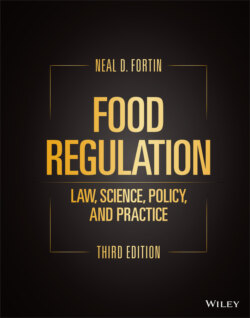Читать книгу Food Regulation - Neal D. Fortin - Страница 17
1.2.2 The 1906 Pure Food and Drug Act
ОглавлениеIn 1883, Dr. Harvey Wiley became the chief chemist of the U.S. Bureau of Chemistry (at that time, part of the Department of Agriculture). Dr. Wiley expanded research and testing of food and documented widespread adulteration.5 He helped spur public indignation by his publications and by campaigning for a national food and drug law. Wiley dramatically focused concern about chemical preservatives as adulterants through his highly publicized “Poison Squad.”6
The Poison Squad consisted of live volunteers who consumed questionable food additives, such as boric acid and formaldehyde, to determine the impact on health. Observation and documentation of the ill effects and symptoms of the volunteers provided an appalling crude gauge of food additive safety.7 However, crude by today’s standards, Wiley’s leadership with the galvanize public awareness and advanced food safety.
Public support for passage of a federal food and drug law grew as muckraking journalists exposed in shocking detail the frauds and dangers of the food and drug trades, such as the use of poisonous preservatives and dyes in food and deadly opiate‐laced syrups for children.8 A final catalyst for change was the 1905 publication of Upton Sinclair’ The Jungle. Sinclair portrayed nauseating practices and unsanitary conditions in the meatpacking industry, such as food handlers sick with tuberculosis and carcasses covered in rat droppings being made into sausage. The book was a best seller, and meat sales dropped by half.9
Outraged at the conditions described in The Jungle, President Theodore Roosevelt sent his own investigators to the Chicago packinghouses. They found the situation as revolting as Sinclair had described, including witnessing a carcass falling into a latrine, being hauled back out, and put back uncleaned with the other meat.10 Even though leaders within the meat industry were ready for new rules, Congress refused to pass a bill. President Roosevelt had held back his investigators’ report, but when Congress would not act, he released the report to the newspapers. Soon Roosevelt had his bill.11
On June 30, 1906, President Theodore Roosevelt signed both the Pure Food and Drug Act12 and the Meat Inspection Act13 into law. Passage of these two statutes began the modern era of U.S. food regulation. While neither act could be considered comprehensive, both responded to the concerns of the day.
The Pure Food and Drug Act added regulatory functions to the U.S. Bureau of Chemistry. The Meat Inspection Act of 1906 required the U.S. Department of Agriculture (USDA) to inspect all cattle, sheep, swine, goats, and horses when slaughtered and processed into products for human consumption. The primary goals of the Meat Inspection Act were to prevent adulterated livestock from being processed into food, and to ensure that meat was slaughtered and processed under sanitary conditions.
